ธรรมวิชัย: ระบบการบริหารการปกครองของพระเจ้าอโศกมหาราช Dhammavijaya or Conquest by Dhamma: The Administrative System by Ashoka the Great
- พระครูปลัดเถรานุวัตร สุเทวเมธี, ดร., ดร.ศิรวัฒน์ ครองบุญ
- 2565
- บทความวิชาการ
บทคัดย่อ
บทความนี้มีวัตถุประสงค์ เพื่อศึกษาระบบการบริหารการปกครองของพระเจ้าอโศกมหาราช ที่ทรงยึดมั่นในหลักแห่งธรรมวิชัย คือ การชนะทางด้านจิตใจ เป็นชัยชนะอันสูงสุด เป็นชัยชนะแห่งธรรมซึ่งเป็นต้นแบบของการเมืองใหม่ที่ใช้ธรรมนำหน้าอย่างแท้จริง ที่สามารถเข้าถึงวิถีแห่งสันติ อหิงสา ขันติธรรม และความสงบสุข โดยที่พระองค์ทรงบริหารราชการแผ่นดินภายใต้นโยบายธรรมวิชัย ซึ่งเป็นระบอบประชาธิปไตยเต็มที่แต่เอนไปทางด้านปิตาธิปไตย คือ ทรงปกครองอาณาประชาราษฎร์ประดุจ พ่อปกครองลูก หรือทรงปกครองแผ่นดินโดยธรรม ส่งเสริมกิจการสาธารณูปการ สวัสดิการสังคม ทำนุบำรุงศิลปะและวัฒนธรรม การจัดบริการสาธารณประโยชน์ และสังคมสงเคราะห์ สร้างศิลาจารึกสื่อสารเสริมธรรม ประกาศหลักการแห่งเสรีภาพ แถลงเรื่องที่เป็นนโยบายของรัฐในทางธรรม ที่จะให้ผู้บริหารปกครองท้องถิ่นนำไปสั่งสอนประชาชน แต่งตั้งธรรมมหาอำมาตย์ เป็นทูตแห่งธรรมในการเผยแผ่พระธรรม โดยพระองค์ก็เสด็จธรรมยาตราไปยังพุทธสถานทุกแห่ง เพื่อศึกษาและปฏิบัติธรรม
พระเจ้าอโศกมหาราชทรงทำสงครามทำลายล้างอย่างยืดเยื้อกับแคว้นกาลิงคะ ปัจจุบันคือรัฐ โอริสสา ทรงเอาชนะแคว้นกาลิงคะ ซึ่งเป็นแคว้นสุดท้ายที่พระองค์ทรงพิชิตได้ เป็นสงครามครั้งยิ่งใหญ่ที่สุด แต่ชัยชนะนั้นกลับสร้างความสลดสังเวชพระทัยแก่พระองค์ ซึ่งทำให้พระองค์ได้รับสมัญญานามว่า จัณฑาโศกราช คือ พระเจ้าอโศกผู้โหดเหี้ยม แต่หลังจากที่พระองค์หันมานับถือวิถีแห่งสันติและเมตตาตามหลักพระพุทธศาสนา จึงทรงประกาศละเลิกสังคามวิชัยหันมาดำเนินนโยบายเดชานุภาพแบบ “ธรรมวิชัย” ด้วยรัฐประศาสโนบายนี้เอง จึงทำให้พระองค์ทรงเป็นต้นแบบของการเมืองใหม่ที่ใช้ธรรมนำหน้า หรือจะกล่าวอีกนัยหนึ่งว่า พระเจ้าอโศกมหาราชได้นำโลกไปสู่ความเมตตา กรุณา อหิงสาและสันติภาพด้วยวิถีทางแห่งความสงบสุข
คำสำคัญ: ธรรมวิชัย, ระบบการบริหาร, การปกครอง, พระเจ้าอโศกมหาราช
Abstract
The purpose of this research is to study the administrative system by Ashoka the Great. His administrative system was dhammavijaya or conquest by dhamma which was the highest victory. Dhammavijaya is a model of new politics idea which is led by dhamma. This new politics approach to way of peacefulness, nonviolence, toleration and tranquility. His administration was dhammavijaya which was considered as part of democracy system and main part of Paternalism. He expressed his attitude of superiority and his power over his people like father and children and applied dhamma to his administration. He supported the construction and renovation of temples, social welfare, arts and cultures, public benefits service, edicts of Ashoka rock inscriptions for dhamma promotion, for declaration of liberty principles and for governmental policy announcement. He assigned the representatives for expansion of Buddhism. He also visited every Buddhist monasteries to study and practice dhamma.
Kalinga or presently known as Orissa had been attacked for long time by Ashoka the Great troops. After his conquest of Kalinga, the greatest victory brought him the great remorse and earned him the name of Chandra Ashoka meaning “Ashoka the Firece”. However, after he had changed his mind to follow the way of peace and metta in the Buddhism, he applied the dhammavijaya instead of the conquest by war. Ashoka the Great is the leader who used the model of new politics idea. He brought the way of loving-kindness, compassion, nonviolence and peacefulness to the world.
Keywords: dhammavijaya, administrative system, government, Ashoka the Great

